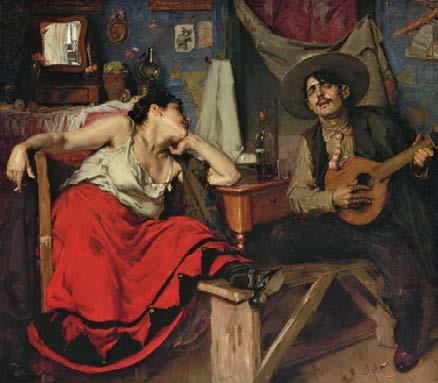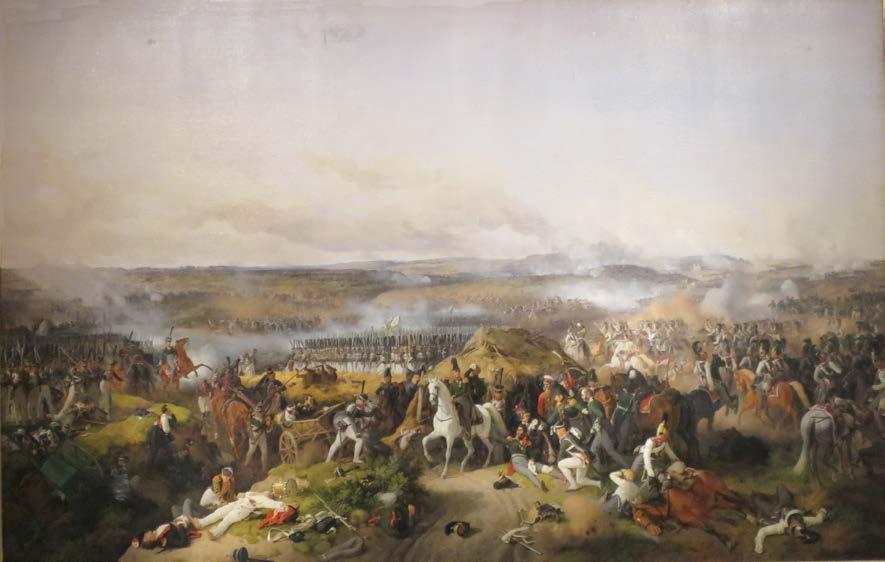
9 minute read
Sexuality and consent through the gaze of the artists
a blurry notion crushed by a patriarchal society
by Juliette Gadenne
Advertisement
How the artists perform or stand up about the notion of consent
In this article, I would like to present some artists who found their way to express and highlight the issue of women’s sexuality and consent in our societies. Some of them were already aware of the situation in the 60’s and were trying to experiment with their body.
It is today an issue that is still very present, for example with the case of the American producer Harvey Weinstein, accused of sexual harassment by dozens of women, the movement #MeToo in 2017 appeared and gave a platform of the huge amount of women experiencing sexual harassment. Indeed, more than 6 millions of women expressed on social media the situations they had been to.
In France, for example, a man tries or achieve to rape a woman every 9 minutes. (Source: France Culture Radio)
All kind of sexual activities without consent is supposed to be considered as a rape or sexual assault.
Definitions surrounding consent and how it should be communicated have been contradictory, limited or without consensus.
The New York Times reports that men typically use nonverbal indicators to determine consent (61 per cent say they perceive consent through a partner’s body language), but women typically wait till a partner verbally asks them before they indicate consent (only 10 per cent say they indicate consent through body language), a differing approach that may lead to confusion in heterosexual couples’ encounters.
Feminist artists participated in raising awareness about women’s conditions. From humour to difficult performances reflecting on society, I invite you to discover some examples which should inspire us all.
Let’s begin softly, with the common culture of sexualizing the woman’s body in the video clips.
Since 1985, the Guerrilla Girls have spoken out against gender inequality through interventions and schematic posters with provocative content often tinged with humour.
« Do women have to be naked to get into music videos » was created in 2014, when Pharrell Williams invited them to his exhibition « G I R L » in Perrotin Gallery in Paris.
Traditions can be against women as well, and especially the genitalia which is a source of sexual pleasure of course! Is it consent to give in to the pressure coming from the family’s culture?
Aide Silvestri worked in the United Kingdom on Female Genital Mutilation (FGM) which is still considered to be a taboo topic as women refuse to talk about it openly.
The project is called Unsterile Clinic.
The aim of this project is to raise awareness of this procedure in the hope that women, young girls and children who may not realize the severity or what type of FGM they are encouraged to go through an early screening process before it becomes an emergency. I also hope that this project encourages medical staff, when examining women affected by FGM, have the courage to speak openly with them about this issue.
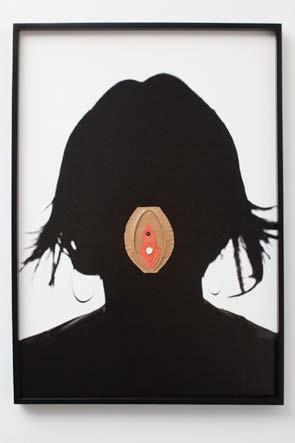
© aidasilvestri.com
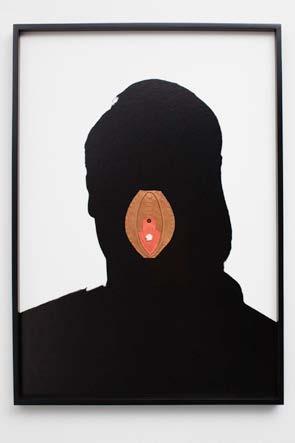
© aidasilvestri.com

© aidasilvestri.com
The leather pieces show the various stages of tissue removal where cutting took place; the portraits are accompanied by short poems from interviews highlighting their FGM experiences.
(Source : Aida Silvestri 2015)
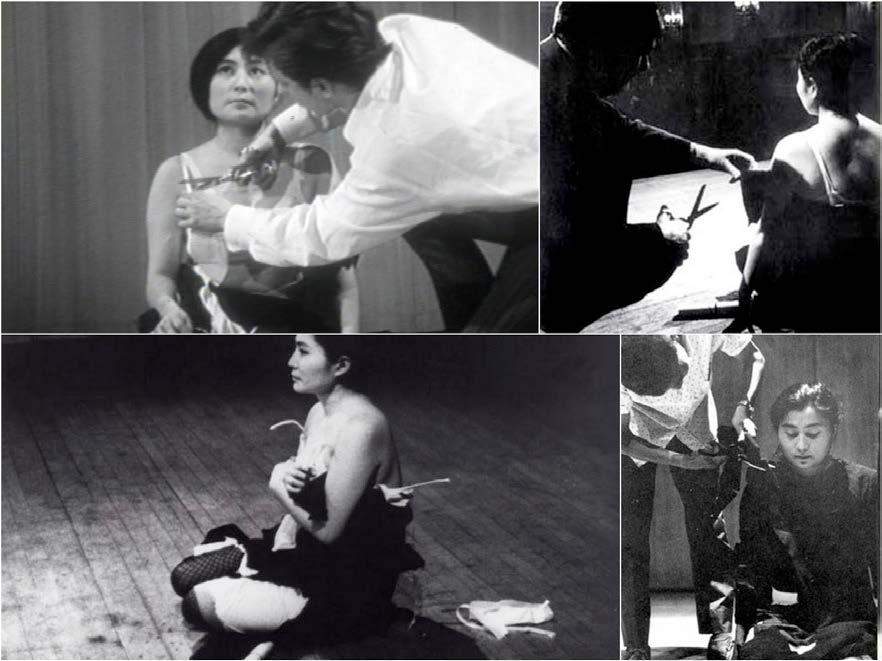
© art-sheep.com
Then, some artists experienced directly social domination with their own bodies as a tool and object.
In Cut Piece, in 1964, Yoko Ono made the first performance in Japan.
Yoko Ono is immobile in front of the public and asks people to come one by one to cut a piece of her clothes. She doesn’t move and let the people do what they want, and at the end, a masculine participant cut the straps of her bra. She doesn’t say anything but begins to move more and more and she ends up to hold back her bra so as not to drop it.
This immobility is a symbol of a woman’s passivity and vulnerability to gender-based and racist violence. In Cut Piece, Yoko Ono does not speak and does not move much. It becomes a sexual object rather than a subject. By allowing others to act on it as if it were an object, it represents the idea of man’s social domination over woman. This idea is amplified by the fact that it was a man who cut the strap of her bra. Helena Reckitt believes that Yoko Ono has created a situation in which the viewer is involved in the potentially aggressive act of exposing the female body.
In 1974 with Rhythm 0, Marina Abramovic did a similar performance in the Neapolitan studio called « Morra » where people can choose to use one of the 72 objects she had placed on a table. The list of props in the work is as follows:
gun, bullet, blue paint, comb, belt, whip, lipstick, pocket knife, fork, perfume, spoon, cotton, flowers, matches, rose, candle, mirror, drinking glass, polaroid camera, feather, chains, nails, needle, safety pin, hairpin, brush, bandage, red paint, white paint, scissors, pen, book, a sheet of white paper, kitchen knife, hammer, saw, piece of wood, axe, stick, bone of a lamb, newspaper, bread, wine, honey, salt, sugar, soap, cake, metal, spear, a box of razor blades, dish, flute, Band-Aid, alcohol, a medal, coat, shoes, chair, leather strings, yarn, wire, sulphur, grapes, olive oil, water, a hat, metal pipe, rosemary, branch, scarf, handkerchief, scalpel, apple.
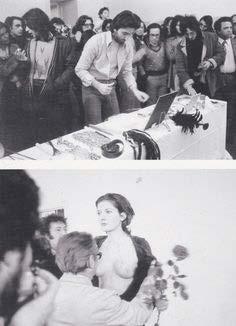
© inuth.com, Pinterest

© inuth.com, Pinterest
Abramovic’s original intention for the piece is explained by her written instructions, which accompanied the work:
Instructions:
There are 72 objects on the table that one can use on me as desired.
Performance:
I am the object.
During this period I take full responsibility.
(quoted in Ward 2009, p.132)
As with many of Abramovic’s artworks, themes surrounding the physicality of the body, endurance, pain and the staging of authentic live actions are dealt with in an experimental way, incurring a degree of personal risk and suffering. The objects that could be ‘used on her’ were chosen to represent both pain and pleasure. Through the personal risk in this work, and her acceptance of that risk, Abramovic also explored collective action and responsibility.
Rhythm 0 is one of Abramovic’s most important works. It was the last artwork in a series of individual body art performance pieces, and according to the artist, it presents ‘the conclusions of my research on the body, when conscious and unconscious’ (Abramovic in Biesenbach 2009, p.74).
They cut her clothes, they hurt her with roses spines, one person put the gun on her head, and another one took it off…
After 6 hours as planned, she stood up and everyone ran away, unable to face her as a person.
The artist wanted to push the body limit to denounce. It reveals something terrible about humans, it is so easy to dehumanize someone, who doesn’t react or doesn’t want to fight. We are ready to act violently to people during unusual circumstances. T
he artist wanted to talk about humans and their behaviour; it is similar to a social experiment. She opens our eyes showing us how much we can be bad or good, no matter who we are.
Marina Abramovic wanted to know how far the public can go when they are completely free to do anything during the performance, as she says in the video “MAI”.
Milo Moiré, a Swedish painter and a psychologist asked people during a performance “Mirror box” to touch her intimates parts (breasts and vagina) to denounce sexual harassment.
Milo Moiré’s performance is a societal reflection of human sexuality. What happens when a woman puts her sexuality on a public display, assertively takes the initiative and lays out clear rules for the intimate interaction? Performance artist Milo Moiré wears a trapezoidal skirt made up of mirrored surfaces; a rectangular opening at the front is closed off by a red curtain. With a megaphone, she invites by-passers to reach into the opening for 30 seconds, in order to touch her vagina.
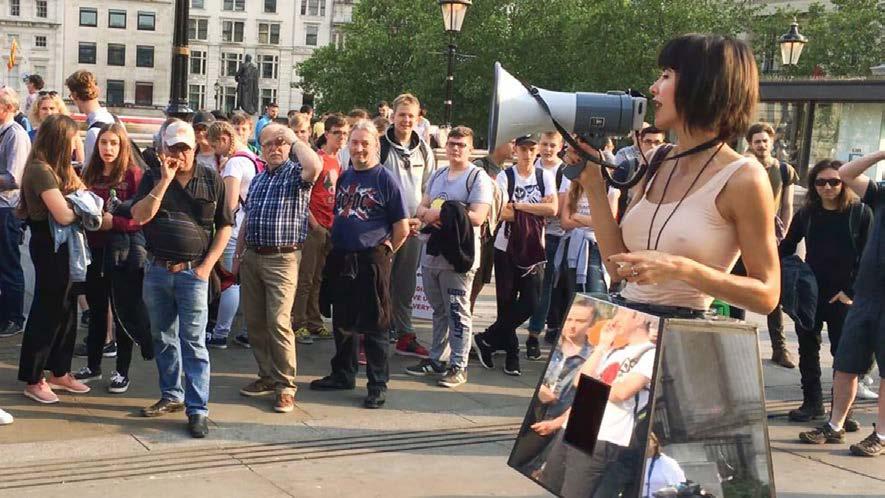
© thedailybeast.com
declared the artist.
Milo Moiré has carried out the “Mirror Box Performance” in Düsseldorf, with the Bosom-Box, as well as in London and Amsterdam, with the Vagina-Box. She was arrested for “outraging public decency” during her art action on London’s Trafalgar Square. After spending 24 hours in jail, a judge sentenced her to pay a fine of €1300 and ordered her release.
“After the sexual assault on hundreds of women on New Year’s Eve in Cologne, it is important to internalize images that show women as equal sexual partners and not as victims,” stated the artist. Moiré has additionally taken the liberty of showing female desire, thus giving women a sexual voice. The artist supplements the dominant image of the female body as a mirror of male desire through the illumination of the libidinous black box of woman.
The audience’s reflection on the mirrored box simultaneously becomes a visual metaphor for the role reversal from voyeur to the object of view: a constant play of inversions analogous to our roles in the digital world.
The sexual assault often tries to justify “she didn’t say NO”. The issue is more about saying YES. Since a young age we are taught about these fairytales of prince charming as within literature and cinema we can see that the erotism is existing mostly through the same kind of scenarios. The girl is waiting, she is asleep, she needs to be saved or she is pushing away the advances which make her “less accessible so more attractive”. This is most of the time presented sex appeal, however, it is a part of our rape culture. All these scenarios are not romantic, they are focused on the man’s desire and they silence and ignore the desire of the woman. By the way, which gender is dominant in literature and cinema?
Other artists:
Rebecca Horn
Barbara Kruger
Kiki Smith
Cindy Shermann
Katrien de Blauwer
Valie Export





